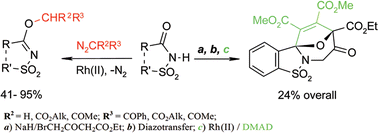Cyclic and acyclic sulfonimides in reactions with Rh(ii)-ketocarbenoids: a new access to chemoselective O-functionalization of the imidic carbonyl groups†‡
Abstract
Catalytic

* Corresponding authors
a
Saint-Petersburg State University, University prosp. 26, Saint-Petersburg, Russia
E-mail:
vnikola@VN6646.spb.edu
Fax: 7 812 4286939
b
Universität Leipzig, Institut für Organische Chemie, Johannisallee 29, 04103 Leipzig, Germany
E-mail:
bschulze@organik.chemie.uni-leipzig.de
Catalytic

 Please wait while we load your content...
Something went wrong. Try again?
Please wait while we load your content...
Something went wrong. Try again?
V. Nikolaev, L. Hennig, J. Sieler, L. Rodina, B. Schulze and V. Nikolaev, Org. Biomol. Chem., 2005, 3, 4108 DOI: 10.1039/B508317F
To request permission to reproduce material from this article, please go to the Copyright Clearance Center request page.
If you are an author contributing to an RSC publication, you do not need to request permission provided correct acknowledgement is given.
If you are the author of this article, you do not need to request permission to reproduce figures and diagrams provided correct acknowledgement is given. If you want to reproduce the whole article in a third-party publication (excluding your thesis/dissertation for which permission is not required) please go to the Copyright Clearance Center request page.
Read more about how to correctly acknowledge RSC content.
 Fetching data from CrossRef.
Fetching data from CrossRef.
This may take some time to load.
Loading related content
